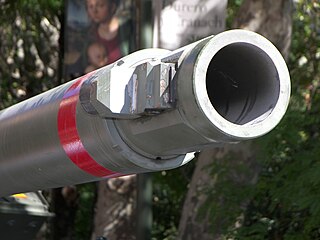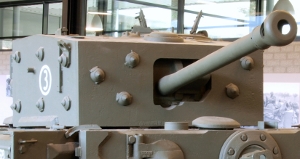Related Research Articles

Artillery is a class of heavy military ranged weapons that launch munitions far beyond the range and power of infantry firearms. Early artillery development focused on the ability to breach defensive walls and fortifications during sieges, and led to heavy, fairly immobile siege engines. As technology improved, lighter, more mobile field artillery cannons developed for battlefield use. This development continues today; modern self-propelled artillery vehicles are highly mobile weapons of great versatility generally providing the largest share of an army's total firepower.

Armour-piercing ammunition (AP) is a type of projectile designed to penetrate armour protection, most often including naval armour, body armour, vehicle armour.

The 8.8 cm KwK 36 was an 88-millimetre (3.5 in) tank gun used by the German Army during World War II. This was the primary armament of the PzKpfw VI Tiger I tank. It was developed and built by Krupp.

A shell, in a military context, is a projectile whose payload contains an explosive, incendiary, or other chemical filling. Originally it was called a bombshell, but "shell" has come to be unambiguous in a military context. Modern usage sometimes includes large solid kinetic projectiles, which are more properly termed shot. Solid shot may contain a pyrotechnic compound if a tracer or spotting charge is used.

The Mk 153 Shoulder-Launched Multipurpose Assault Weapon (SMAW) is a smoothbore shoulder-fired rocket launcher. It is a portable assault weapon and has a secondary anti-armor ability. Developed from the B-300, it was introduced to United States Armed Forces in 1984. It has a maximum effective range of 500 metres (550 yd) against a tank-sized target.
20 mm caliber is a specific size of popular autocannon ammunition. It is typically used to distinguish smaller-caliber weapons, commonly called "guns", from larger-caliber "cannons". All 20 mm cartridges have an outside projectile (bullet) diameter and barrel bore diameter of 0.787 inches (20.0 mm). These projectiles are typically 75 to 127 mm (3–5 in) long, cartridge cases are typically 75 to 152 mm (3–6 in) long, and most are shells, with an explosive payload and detonating fuze.

The Rheinmetall Rh-120 is a 120 mm smoothbore tank gun designed and produced in former West Germany by the Rheinmetall-DeTec AG company, it was developed in response to Soviet advances in armour technology and development of new armoured threats. Production began in 1974, with the first version of the gun, known as the L/44 as it was 44 calibres long, used on the German Leopard 2 tank and soon produced under license for the American M1A1 Abrams and other tanks. The 120-millimetre (4.7 in) gun has a length of 5.28 metres (17.3 ft), and the gun system weighs approximately 3,317 kilograms (7,313 lb).

The Ordnance QF 75 mm, abbreviated to OQF 75 mm, was a British tank gun of the Second World War. It was obtained by boring out the Ordnance QF 6-pounder 57 mm anti-tank gun to 75 mm, to give better performance against infantry targets in a similar fashion to the 75 mm M3 gun fitted to the American Sherman tank. The QF came from "quick-firing", referring to the use of ammunition where the shell has a fixed cartridge. The gun was also sometimes known as ROQF from Royal Ordnance Quick-Firing.

The L118 light gun is a 105 mm towed howitzer. It was originally designed and produced in the United Kingdom for the British Army in the 1970s. It has since been widely exported. The L119 and the United States Army's M119 are variants that use a different type of ammunition.

The Mk44 Bushmaster II is a 30 mm chain gun manufactured by Northrop Grumman. It is a derivative of the 25 mm M242 Bushmaster, and uses 70% of the same parts as the M242 while increasing the firepower by as much as 50% with the 20% increase in caliber size. The barrel is chromium-plated for extended life. The gun uses standard GAU-8 Avenger ammunition that is available in API, HEI and APFSDS-T variants. The gun can be converted to a caliber of 40x180 mm, which involves changing the barrel and a few key parts, to use the SuperShot 40 cartridge. It can also be converted to use the 30x170 mm RARDEN cartridge.

The M829 is an American armor-piercing fin-stabilized discarding sabot (APFSDS) tank round. Modeling was done at the Ballistic Research Laboratory at Aberdeen Proving Ground, which was incorporated into the Army Research Laboratory in 1992. The round is specifically designed for the 120 mm M256 main gun on the Abrams M1A1 and M1A2 main battle tanks. The penetrator is carried by a sabot during its acceleration in the gun barrel.

The L30A1, officially designated Gun 120 mm Tk L30, is a British-designed 120 mm rifled tank gun, installed in the turrets of Challenger 2 main battle tanks. It is an improved production model of the Royal Ordnance L11 series of rifled tank guns. Challenger 2 tanks, and their L30A1 guns, are operated by the British and Omani armies. In 2023, L30A1 armed Challenger 2 tanks supplied by the British were delivered to Ukraine.

Ammunition is the material fired, scattered, dropped, or detonated from any weapon or weapon system. Ammunition is both expendable weapons and the component parts of other weapons that create the effect on a target.

The defense industry of Turkey has a long history, dated from the Ottoman Empire and changed several times.

The M18 recoilless rifle is a 57 mm shoulder-fired, anti-tank recoilless rifle that was used by the U.S. Army in World War II and the Korean War. Recoilless rifles are capable of firing artillery-type shells at reduced velocities comparable to those of standard cannon, but with greater accuracy than anti-tank weapons that used unguided rockets, and almost entirely without recoil. The M18 was a breech-loaded, single-shot, man-portable, crew-served weapon. It could be used in both anti-tank and anti-personnel roles. The weapon could be both shoulder fired or fired from a prone position. The T3 front grip doubled as an adjustable monopod and the two-piece padded T3 shoulder cradle could swing down and to the rear as a bipod for the gunner. The most stable firing position was from the tripod developed for the water-cooled Browning M1917 machine gun.

The Royal Ordnance L11A5, officially designated Gun 120 mm Tk L11, is a 120 mm L/55 rifled tank gun design. It was the first of NATO's 120 mm main battle tank guns which became the standard calibre for Western tanks in the later period of the Cold War. A total of 3,012 of the L11 guns were produced by 2005. The list price was US$227,000 in 1990.

The Gryazev-Shipunov GSh-30-1 is a 30 mm autocannon designed for use on Soviet and later Russian military aircraft, entering service in the early 1980s. Its current manufacturer is the Russian company JSC Izhmash. The name GSH-30-1 is formed from the surnames of the designers Gryazev (Грязев) and Shipunov (Шипунов), the caliber of 30 mm and the single-barrel design of the gun itself.

120×570mm NATO tank ammunition, also known as 120×570mmR, is a common, NATO-standard, tank gun semi-combustible cartridge used by 120mm smoothbore guns, superseding the earlier 105×617mmR cartridge used in NATO-standard rifled tank guns.
References
- ↑ "M830/M830A1" (PDF). Archived (PDF) from the original on 2021-05-02.
- 1 2 "TM 43-0001-28" (PDF). Archived (PDF) from the original on 2021-09-05.
- ↑ "ARDEC: History". Archived from the original on 2006-12-10. Retrieved 2007-02-13.
- ↑ "M830A1 HEAT (High Explosive Anti-Tank)". Archived from the original on 2017-04-09.
- ↑ "TM-9-1300-251-20&P" (PDF). Archived (PDF) from the original on 2021-05-02.
- ↑ "Army Ammunition Data Sheets for Artillery Ammunition Guns, Howitzers, Mortars, Recoilless Rifles, Grenade Launchers and Artillery Fuzes (Federal Supply Class 1310, 1315, 1320, 1390)" (PDF) (Technical Manual). Washington, D.C. April 1994. p. 154. TM 43-0001-28. Archived from the original (PDF) on 2019-02-28.
- ↑ "M830A1 High Explosive Anti-Tank-Multi Purpose - Tracer (HEAT-MP-T)". GlobalSecurity.org. Archived from the original on 2007-02-17.
- ↑ Hill, Paul (8 May 2012). "NDIA Joint Armaments Conference: PM Panel" (PDF). Archived from the original (PDF) on 2020-01-13.
- ↑ Orbital ATK Awarded Next Phase Advanced Multi Purpose 120mm ammunition Development Archived 2017-01-29 at the Wayback Machine - Armyrecognition.com, 24 January 2017